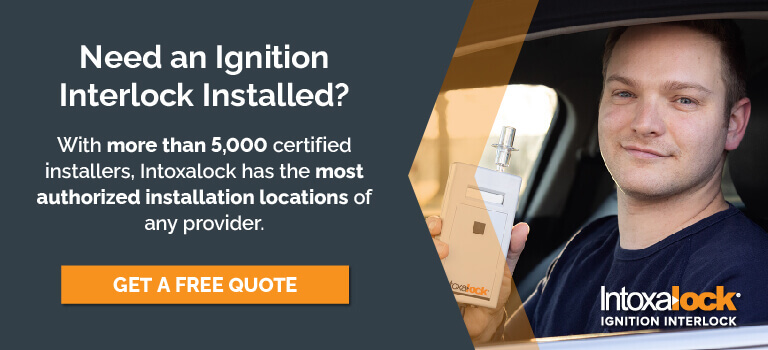Top 5 Causes Of An Intoxalock Lockout
Originally posted on 10/25/18, updated 4/3/2024 and 1/9/2025.
The Intoxalock device is designed to be easy to use, and your technician will explain how it works during installation. However, following simple guidelines can help you avoid an ignition interlock device (IID) lockout.
An IID lockout occurs if the device detects certain conditions or behaviors, preventing you from starting your vehicle. While it can be inconvenient, understanding ignition interlock lockout causes and how to avoid them will make your experience much smoother.
Two Types of Ignition Interlock Device Lockouts
There are two main types of IID lockouts, each with different implications:
1. Temporary Lockout
A temporary lockout occurs when the device detects a prohibited condition. The device will initiate a countdown lasting several minutes, during which you can’t start your vehicle. After the countdown ends, you’ll be able to provide another breath sample. If your sample meets the legal requirements, you can start your car.
2. Service Lockout
An IID service lockout is more serious and requires action to resolve. It’s indicated by a countdown lasting several days. If you reach the end of this countdown without resolving the issue, your IID will need to be serviced or replaced. You can often reset your device through the Intoxalock Mobile App or by contacting customer service.
IID lockouts are state-mandated safeguards designed to ensure compliance. Each state has its own rules regarding what triggers a lockout and how it must be resolved. Always consult your state specialist for guidance.
Top 5 Causes of a Lockout
Understanding common triggers for IID lockouts can help you avoid them. Here are the top five causes:
1. Failed Breath Sample
Failing a breath test is the most common cause of lockouts. If your breath alcohol concentration (BrAC) exceeds the legal limit, the device will prevent you from starting your car. Too many failed attempts can result in a temporary or service lockout. To avoid this:
- Wait 10-15 minutes after eating, drinking, smoking, or using products containing alcohol before submitting a sample.
- Rinse your mouth with water if you suspect non-beverage alcohol sources might affect your test.
If you need help operating your ignition interlock, learn how to use your device.
2. Missed Retests
Random retests are a key feature of IIDs. If you miss a retest while driving, the device won’t shut off the vehicle, but it may initiate a lockout when you turn the car off. Always provide retests promptly and safely to avoid this. After turning off your vehicle, and before exiting, check to make sure there are no pending retests requested. If the device display starts with “RESTART WITHIN...” then you may leave your vehicle.
3. Missed Calibration
IIDs require regular calibration—typically every 30 to 120 days, depending on your state’s requirements. Missing a calibration deadline can result in a service lockout. To avoid this:
- Schedule your calibration appointment well in advance.
- Use the Intoxalock Mobile App to track calibration deadlines and locate service centers.
4. Tampering with the Device
Any attempt to tamper with or bypass the IID will trigger an IID lockout. This includes having someone else provide a sample or trying to disable the device. Modern IID technology detects tampering attempts, and many states require cameras to verify who provides the breath sample.
5. Incorrect Vehicle Maintenance
During vehicle maintenance, the IID may interpret a loss of power as tampering. Notify Intoxalock before scheduling maintenance and inform your mechanic about the IID. Use the “Report Vehicle Maintenance” feature in the Intoxalock Mobile App to minimize complications.
How to Avoid Ignition Interlock Lockouts
Following these tips will help you avoid ignition interlock lockouts:
- Time Your Breath Tests: Wait at least 10-15 minutes after eating, drinking (anything other than water), smoking, or using products like mouthwash before providing a sample.
- Don’t Leave Your Car Too Soon: You may be prompted for a retest any time your car is running. Do not leave your car when it is running or immediately after turning it off until you confirm you aren’t being prompted for a retest.
- Rinse and Ventilate: If you blow a BrAC reading due to non-alcoholic sources, rinse your mouth with water and air out your vehicle before retesting.
- Stay on Schedule: Always respond to test prompts immediately and don’t leave your car running unattended.
- Ensure Battery Health: Keep your vehicle’s battery charged and in good condition to prevent power interruptions that might trigger a lockout.
- Be Mindful of Alcohol Consumption: Alcohol can remain in your system for 12-24 hours, and BrAC levels can fluctuate. Plan accordingly if you’ve been drinking.
What to Do During an IID Lockout
If you experience an IID lockout, follow these Intoxalock lockout solutions to resolve the issue quickly:
1. Temporary Lockout
- Wait for the countdown timer to expire.
- Provide a clean breath sample when prompted. Ensure you’ve waited long enough after consuming anything that might affect the reading.
2. Service Lockout
- Check the Intoxalock Mobile App to see if your state allows remote lockout resets.
- If a reset isn’t available, contact Intoxalock’s 24/7 customer support team for assistance.
- Schedule an appointment at your nearest service center if your device requires servicing or replacement.
3. General Tips
- Stay calm and follow the device’s prompts.
- Don’t attempt to tamper with or bypass the IID—this can worsen the situation and may violate state laws.
- Use the instructional resources available in the Intoxalock Mobile App, including how-to videos and troubleshooting guides.
By understanding how IID lockouts work and what to do if they occur, you’ll stay on the road with minimal interruptions. If you have further questions, Intoxalock’s support team is always ready to help.




